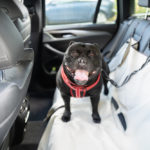Dogs that suffer from disabilities or bad health conditions tend to be quickly abandoned or sent to shelters, sometimes even put down, because the owners feel as though they cannot take care of them, or that they do not know how to deal with a dog like that.
Dogs that are both blind and deaf are a good example of this, as many people fear that these dogs are unfit and unable to interact with the world around them and that they cannot live a happy life as a consequence of this.

But we’re here to tell you that this could not be further from the truth. Because yes, dogs that are both blind and deaf are going to be hard to deal with, and these dogs are going to really struggle to get by, as two of their most important senses are gone.
But they can still enjoy life! And with the right care and training, dogs that are both blind and deaf can thrive and learn, and be as happy as any other dog!
Of course, training a blind and deaf dog is going to take a lot of patience, and a lot of love. It will not be an easy task, and you should know beforehand that you will need to be devoted, and be very gentle along the process.
If you think you are up for the job and are ready to give it your all, then keep reading! We have plenty of tips and tricks on how to train a blind and deaf dog, and with time, you will see that it is simply adapting to focusing on the senses they still have use of.
Things To Do When Training A Blind And Deaf Dog
All dogs need regular training. But with a dog that is both deaf and blind, you have to take a different approach and adapt to the senses that they still have.
Here are some of the basic and main things that you should do when training a blind and deaf dog. Consider them our golden rules:
Keep The Dog’s Mind Active
Dogs need a lot of exercises, both physical and mental. Exercising a blind and deaf dog can be a bit challenging, as they will struggle a lot more on walks, and you will have to have a lot of patience and make them feel safe on a familiar path.
And as they are missing two vital senses, they might also get less mental stimulation.
This is why it is so important to ensure they are keeping their mind active and engaged with their surroundings, by utilizing the other senses left, mainly their sense of smell and their sense of touch.
A good trick to use is working to eat, which essentially has them “work” for their food. You can do this by using feeders and bowls that have integrated puzzles and problems to solve so that they have to mentally engage in order to be able to access the food.
This keeps them thinking on a daily basis and makes sure they stay interactive and able to learn and progress.
Use scented mats
When it comes to training a blind and deaf dog, it is very important that you first and foremost focus on safety.
The first thing that you teach the blind and deaf dog should be focused on keeping the dog safe and out of harm, so for example things to keep your dog able to get around the house.
One of the main things we like to implement when training a blind and deaf dog is scented mats. These are essentially mats, which you can scent with the fragrance of your choosing (the fragrance should be appealing to the dog, and should relate to the purpose of the mat).
For example, you could have a relaxation mat, which is where the dog can go and rest or spend the time, and you could scent it with something like lavender. (Make sure the scent isn’t too strong, or else it will overwhelm the dog).
The idea is that the dog will be able to smell the mat, in order to locate it, and with time the dog will associate each mat with the purpose and will go there when needed.
This is also a great way to be able to know where your dog is at any given moment, as you can have several mats in different parts of the house, which your dog will shift between.
Create Textured Surfaces And Pathways
A blind and deaf dog cannot see or hear in order to get around, and this can make things very difficult.
In fact, most blind and deaf dogs tend to be quite reserved and fearful, as they do not feel safe moving about the place or interacting with their environment, as they feel vulnerable to it.
This is why you have to make their environment safe for them, by adapting it to their senses.
Touch is the main thing they will use in order to get around, so make it easier for them by laying out paths throughout the house with the use of textured surfaces, carpets, barriers, and the likes.
For example, you could create paths made out of carpet, and the dog will know that while they are on the carpet, they are safe and won’t bump into any obstacles.
With time, your dog will get used to these pathways and textures directives within the environment, like barriers or “doors”. This will help them become more confident so that they can get by on their own, happily!
Teach Your Dog Touch Signals
One of the most useful tools in dog training is the clicker. You press it and make the clicking noise every time your dog does something good, and your dog then is able to identify what behavior is good, and what is then praised with treats.
However, auditory or visual reinforcement will not work on a blind and deaf dog, for obvious reasons.
Repetition And Patience Are More Important Than Ever
Training a dog, in general, always takes a lot of patience and repetition. But blind and deaf dogs struggle a lot more, and you need to be extra gentle, extra patient, and even more consistent.
There will likely be setbacks, but it is important that you don’t give up and that you keep pushing until the dog adapts to the new form of training and to the new methods you are implementing to adapt to the loss of sight and hearing.
Summary
Blind and deaf dogs can still live a fulfilling and happy life, and they can still learn and train just like other dogs, they just need a training method that adapts to their specific needs.
Start by adapting their environment so that they are safe, and can feel comfortable and confident. Make sure they remain mentally active and engaged, so that they still interact with the world around them, despite being limited in doing so.
And finally, implement different training methods and techniques that make use of their sense of smell and touch, in order to create new associations, reinforcements, and ways to get around. They need a lot of patience, and some extra love, but blind and deaf dogs can still thrive!
- 8 Signs That Your Dog Is In Heat - November 8, 2022
- Why Is My Dog Whining Whilst Carrying A Toy In Their Mouth? - August 17, 2022
- Reasons Why Your Dog’s Poop Is White And What To Do About It - August 17, 2022








